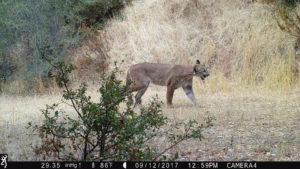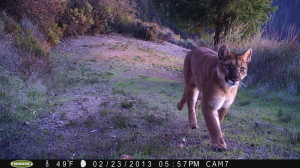When a 100-pound adult mountain lion showed up at 3 a.m. along Shattuck Avenue in North Berkeley, anyone with a little knowledge of state game policies and general wildlife issues could tell you that things weren’t going to end well for that lion.
Much of the discussion we’ve seen online has been critical of the Berkeley Police Department’s handling of the situation. A shrine at the corner of Cedar and Shattuck mourns the loss of the lion (and prominently features Bay Nature’s April 2010 cover article on Easy Bay mountain lions, also called pumas or cougars).
On Wednesday, September 15, at 7:30 p.m. community members and puma researchers will get a chance to talk it all over in person at the recreation center in Live Oak Park, at 1301 Shattuck Avenue. The Felidae Conservation Fund, which is conducting groundbreaking puma research in the Santa Cruz Mountains, will sponsor the forum, along with the Live Oak/Codornices Creek Neighborhood Association, the Close to Home nature education group, the Bay Area chapter of the Sierra Club, Berkeley Animal Care Services, and the Berkeley Humane Society.
“We want to enable the members of the community to voice thoughts and opinions,” says Zara McDonald, the Felidae Fund’s director, “and also to have an opportunity to share what’s going on with the future of the possibility of having pumas and humans live peacefully together on the landscape.”
The situation in Berkeley is probably more important for the spotlight it puts on pumas statewide than for any new surge in cougars roaming highly urbanized areas.
“It’s such an obscure situation to begin with,” says McDonald, whose group is spearheading the Bay Area Puma Project, currently tracking lions on the Peninsula, with plans to expand into the East Bay. “The cats are chasing prey down into an area where we know deer move. The biggest thing we can do is raise awareness.”
For pumas all over the state, the most important problems are habitat fragmentation, perilous road crossings, and depredation permits that allow cats to be killed if they prey on pets or livestock.
“One of things that people are not aware of is that these cats require tremendous tracts of land to move,” says McDonald. Females’ ranges average 50 square miles and males as much as 150 or 200. So the female lion shot in Berkeley could just as easily have wandered east to watershed lands managed by the East Bay Municipal Utility District.
But big open spaces uncut by roads are few and far between. “The main issue here really is about movement corridors for these cats to disperse and get out of human-dominated zones,” says McDonald. “Barriers to movement are a major driver in more than half of the puma mortalities that we see.”
Marc Kenyon, statewide mountain lion coordinator for the Department of Fish and Game, says there are no comprehensive data sets of road-killed cougars across the state, but radio collar studies in Southern California put traffic deaths right at the top of the list.
And then there are depredation permits issued by Fish and Game for animals that have preyed on pets or livestock. From 2005 to 2008, 301 lions were shot statewide under depredation permits, compared to just 23 lions killed for public safety reasons. So depredation permits account for at least ten times the annual mortality compared to public safety incidents like the one in Berkeley.
How does that compare to the total lion population? The official number is 4,000 to 6,000 pumas resident in California. But Mountain Lion Foundation Director Tim Dunbar points out that there are no statewide studies, so the total number is at best a “guesstimate” and some researchers believe the total number is lower.
Given that total, 50 or 100 lions a year shot for depredation is a lot of lions. And since lion territories don’t overlap much, a few lion kills can make a big difference in a specific place.
“If you leave your cat or dog outside and it happens to be taken by a puma, you can take that cat down,” says McDonald. “It’s not that hard to properly house your animals. But we have found that some small ranchers in Santa Cruz are really unaware of how to do that.”
So both Dunbar and McDonald’s groups are working on education programs in various parts of the state to try to bring down the number of lions killed under depredation permits.
Back in 2001, the Mountain Lion Foundation started a “Living with Lions” program and focused on Plumas County, where just a few hobby ranchers were taking out permit after permit, killing lion after lion. “The rural environment has changed so much with five-acre ranchettes with two or three goats,” says Dunbar. “”That’s what we really have been working on in the past, to get those depredation numbers down.” After meeting with local 4H groups and others in the community, Dunbar’s group was able to turn that situation around.
Even with hundreds of lions killed under permit each year, California is way ahead of other states in lion protections. It’s the only state with a viable puma population where sport hunting of lions is prohibited, thanks to voter-approved Proposition 117, which just turned 20 years old in June 2010.
“This is an ongoing experiment in California,” says Dunbar. “We haven’t had a season on lions here since the 1970s. So you have a state with possibly the highest population of lions and the greatest number of humans. Frankly we’re doing pretty good with that mix.”

.jpg)



-300x196.jpg)